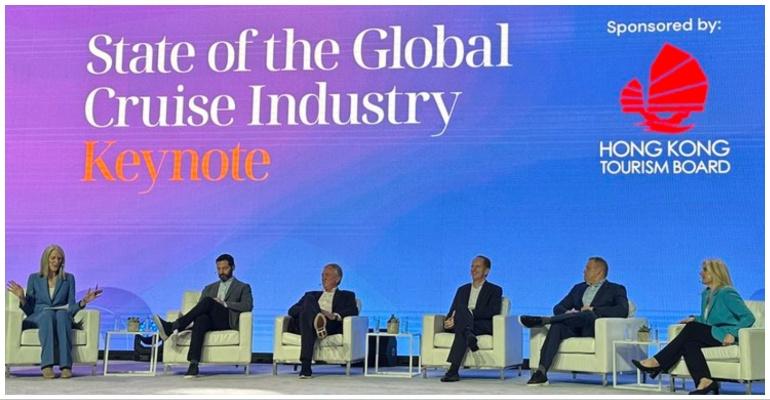“The concept of pent-up demand for cruising is gone,” declared Josh Weinstein, one of four cruise company leaders on the panel for the marquee event. He noted record levels of early booking for 2025 are a sign not of rebound, but of normalcy.
“We have been cruising for three years (since the pandemic pause),” said Weinstein, who is president, CEO and chief climate officer at Carnival Corp. & plc.
“This is natural demand,” Weinstein said.

A full house for Seatrade Cruise Global's State of the Industry keynote
'Virtuous cycle' returns
Other CEOs on stage for the hour-long talk welcomed the return of the “virtuous cycle” of consumer behavior in which enough people have gone cruising to return home and share their happy experiences with family, friends and neighbors.
Harry Sommer, president and CEO of Norwegian Cruise Line Holdings, referred to the “flywheel” of consumers on ships really spinning off new cruisers in 2024. “The ubiquity of social media really helps in this endeavor,” he said.
Sommer said studies show that first-time cruise vacations are almost always inspired by comments from trusted sources. “It could be friends, family, a neighbor, relatives. That positive word of mouth is really huge for our industry,” he said.
31.7m cruisers in 2023
Some 31.7m people cruised globally in 2023, according to figures cited by Cruise Lines International Association President and CEO Kelly Craighead, another panelist. She said CLIA projects growth to 34.1m cruisers this year and 36.4m in 2025.

CLIA's Kelly Craighead announced the global passenger count for 2023 was 31.7m
With those numbers, cruise lines are once again ramping up business with the European shipyards. NCLH wowed the industry on Monday by placing an eight-ship order with Fincantieri to be spread over a decade from 2026-36.
That follows smaller orders for Royal Caribbean International and Carnival Cruise Line announced in recent weeks.
Orderbook variation
But while united on the bright business outlook, the companies diverge a bit on newbuild ambitions with Norwegian’s boldness contrasting with Carnival’s relative caution. NCLH has 13 ships on order, Royal Group has nine, MSC Group eight and Carnival Corp. only four.
“I know, biggest company, smallest orderbook,” said Weinstein. “We’re not embarrassed.”
Weinstein said Carnival’s approach reflects in part the financial hangover from the pandemic. “We can’t beat around the $30 billion bush,” he noted, referring to the company’s debt level. He said a priority is paring debt to bring more equity to its capital structure and to be ready for any future uncertainties.
But he said any of the cruise companies on the panel would be justified in ordering a lot of ships in the next 15 years based on current industry dynamics.
Differing China strategies
Panelists also differed notably on their approach to China, with Royal Caribbean International and MSC Cruises jumping back into the market this year, while Carnival Corp. and NCLH are hanging back for the time being.
“We see the bookings are strong,” said Pierfrancesco Vago, executive chairman of the cruise division at MSC Group.
Vago said that visas are harder to get around the world, as well as in China, so cruises represent low-hanging fruit for travel-hungry Chinese. “They can see Asia, Korea, Japan. And it’s not anymore the shopping cruise that it was before.”
Sommer said that with a smaller overall fleet, NCLH may wait three to five years to return to China, while Weinstein wished his China-bound competitors great success, suggesting that might divert them from Carnival’s markets elsewhere.
Regulatory uniformity needed in path to net zero
Consensus emerged again on the subject of decarbonization where all of the CEOs urged uniformity in global goals and regulations. Vago said the European Union’s vanguard position in regulation has put Europe out of step and made cruising from Europe more costly. Sommer cited a half dozen regulatory regimes that cruise lines must obey, some in conflict with others.
“If we were to focus on the goal rather than mandating specific steps we would be able to reach that goal much quicker,” Sommer said. “I think this is one of the few things that we are 100% aligned on.”
In the US, Liberty forecast the continued build out of port shore power facilities, and said he hoped the electrical grid could be improved to deliver more nuclear-generated electricity to power ships in port.
Available, scalable and affordable fuels needed
Any replacements for fossil fuels must be “available, scalable and affordable,” Liberty said. Most important, government, suppliers and the industry must agree on common standards before the industry can invest in new ships.
“We kind of need to know where we’re skating to,” Liberty said.

From left, Seatrade Cruise Group Director Mary Bond, Carnival Corp. & plc's Josh Weinstein, MSC Cruises' Pierfrancesco Vago; State of the Industry moderator Anne Kalosh, editor, Seatrade Cruise News; NCLH's Harry Sommer, Royal Caribbean Group's Jason Liberty, CLIA's Kelly Craighead; Andrew Williams, president, maritime group & EVP Informa Markets
Copyright © 2024. All rights reserved. Seatrade, a trading name of Informa Markets (UK) Limited.
Add Seatrade Cruise News to your Google News feed.  |

